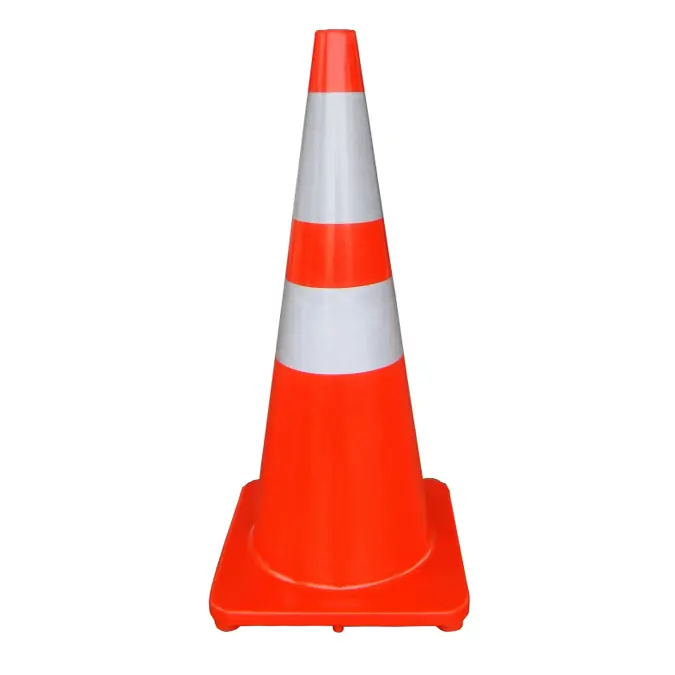Traffic cones play a crucial role in enhancing road safety, particularly in construction zones and other temporary traffic situations, by providing clear visual cues to drivers and pedestrians. Here’s how traffic cones contribute to road safety:
- Traffic Guidance: Traffic cones are used to create a physical barrier and guide drivers away from hazardous areas, roadwork, construction zones, or accidents. They help prevent vehicles from entering restricted areas, reducing the risk of accidents.
- Lane Marking: Cones are often placed to mark lanes, helping drivers stay within their designated lanes and maintain proper lane discipline. This reduces the chances of side-swiping and collisions.
- Visibility: Traffic cones are typically bright orange, fluorescent, or reflective in color, making them highly visible even in low-light conditions. Their color and reflective strips improve visibility during the day and night.
- Warning of Hazards: Cones are positioned around hazards such as potholes, fallen trees, debris, and other obstacles on the road. This warns drivers to take caution and avoid potential dangers.
- Temporary Obstacle Indicators: When roadwork is in progress, traffic cones alert drivers to the presence of temporary obstacles, machinery, and construction materials. This allows drivers to navigate safely around the work area.
- Reduced Speed: Drivers tend to slow down when they see traffic cones ahead. This reduction in speed is important for safety in construction zones where workers are present or when road conditions change.
- Pedestrian Safety: In addition to drivers, traffic cones also help protect pedestrians in work zones. They create a physical barrier, preventing pedestrians from wandering into active roadwork areas.
- Marking Detours: Traffic cones are used to mark detour routes and lane closures, guiding drivers through temporary changes in traffic patterns. This ensures that traffic continues to flow smoothly.
- Emergency Situations: Cones can be quickly deployed to create a safe buffer around accident scenes, providing a protective space for emergency responders, investigators, and accident victims.
- Regulatory and Temporary Signs: Cones often hold temporary regulatory signs, warning signs, and detour signs. This combination of cones and signage helps convey important information to drivers.
- Visibility During Adverse Weather: Traffic cones maintain their visibility even in adverse weather conditions, such as rain, fog, and snow, when other markers and signs may be less visible.
- Temporary Work Zones: In construction zones and maintenance areas, cones define the boundaries of the work area, helping workers and equipment stay safe while minimizing interruptions to traffic flow.
- Quick Setup and Removal: Traffic cones are easily deployed and retrieved, allowing for efficient traffic management in temporary situations.
In summary, traffic cones are versatile and highly visible tools that provide essential guidance and safety measures in construction zones and other temporary traffic situations. China traffic cone manufacture Their bright color, reflective properties, and role as physical barriers contribute to improved road safety and reduced accident risks.
How are traffic cones designed to be highly visible to drivers, especially in low-light conditions?
Traffic cones are designed to be highly visible to drivers, especially in low-light conditions, through a combination of features that enhance their visibility. Here’s how traffic cones achieve this:
- Bright Color: Traffic cones are typically manufactured in fluorescent orange, which is a highly conspicuous and attention-grabbing color during daylight hours. The bright orange color stands out against the road or work zone, making the cones visible to drivers.
- Reflective Bands: Many traffic cones are equipped with reflective bands or sleeves. These bands are made from retroreflective materials that are designed to bounce light back toward its source. When vehicle headlights or other light sources strike the bands, the light is reflected directly back to the drivers’ eyes, making the cones highly visible at night.
- Reflective Collars: In addition to reflective bands, some traffic cones have reflective collars encircling the cone at various heights. These collars provide additional points of reflection and enhance the cone’s visibility, especially when viewed from different angles.
- Fluorescent Materials: The bright color of traffic cones is often achieved with day-glow or fluorescent materials, which remain highly visible even under overcast conditions or in low-light settings.
- Reflective Materials: The top portion of many traffic cones is made from reflective materials, which enhance visibility during the day and night. These materials can reflect headlights and other light sources, making the cones easily identifiable in dark conditions.
- Height and Shape: Traffic cones are typically designed to be tall and conical, with a wide base and a pointed top. This shape enhances visibility and allows the cones to be seen from various angles.
- Tapered Design: The tapered design of traffic cones allows them to be easily stacked for storage, and this design also helps in deflecting the wind and keeping the cone stable in windy conditions.
- Weather Resistance: Traffic cones are designed to withstand various weather conditions, including rain, snow, and extreme temperatures. Their materials and coatings are chosen to resist fading, cracking, and deterioration due to exposure to the elements.
- Low Center of Gravity: The wide base and low center of gravity make traffic cones stable and less likely to tip over in the presence of wind or passing vehicles.
- Weighted Base: Many traffic cones have a weighted base, which provides extra stability and ensures they remain upright even when vehicles pass close by.
- Visibility in Adverse Conditions: Traffic cones are constructed to maintain their visibility in adverse conditions, such as rain, fog, or snow, making them reliable tools for road safety.
These design elements work together to make traffic cones highly visible to drivers, especially during low-light conditions, enhancing road safety in various scenarios, including construction zones and temporary traffic situations.
